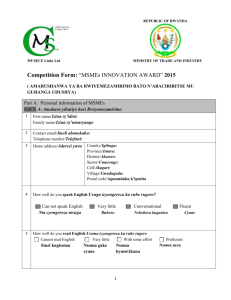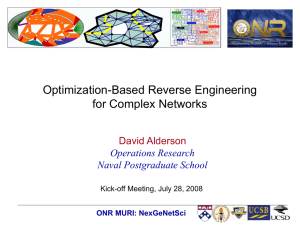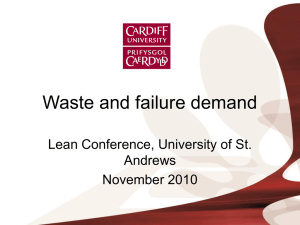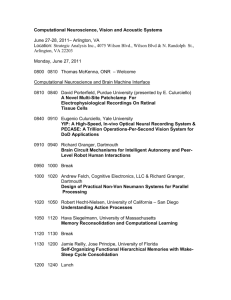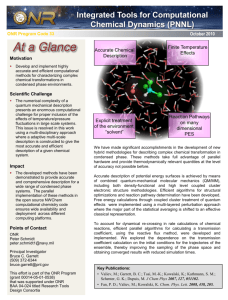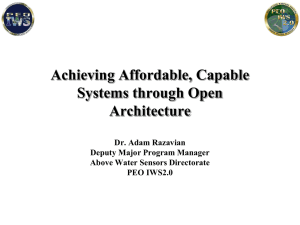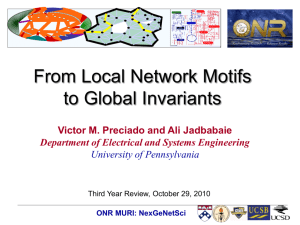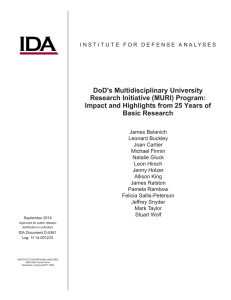Graph Theory to Algebraic Topology
advertisement
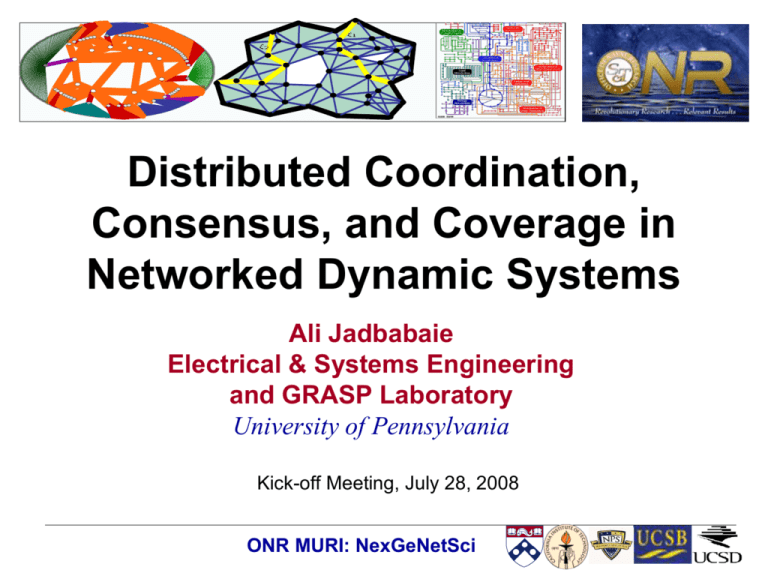
Distributed Coordination, Consensus, and Coverage in Networked Dynamic Systems Ali Jadbabaie Electrical & Systems Engineering and GRASP Laboratory University of Pennsylvania Kick-off Meeting, July 28, 2008 ONR MURI: NexGeNetSci Good news: Spectacular progress ONR MURI: NexGeNetSci Challenges in the NS report: 1. Dynamics, spatial location, and information propagation in networks. 2. Modeling and analysis of very large networks. 3. Design and synthesis of networks. 4. Increasing the level of rigor and mathematical structure. 5. Abstracting common concepts across fields. 6. Better experiments and measurements of network structure. 7. Robustness and security of networks. ONR MURI: NexGeNetSci Complexity: dynamics vs. size Single agent System size State dimensionality low infinite ONR MURI: NexGeNetSci Multi-agent Substantial Recent Progress ONR MURI: NexGeNetSci Case Study: Emergence of Consensus, synchronization, flocking ONR MURI: NexGeNetSci An intuitive model The value of each agent is updated (in discrete time) as a weighted average of the value of its neighbors: Neighborhood relation might depend on actual value, resulting in change in topology The neighboring relationship between the agents was represented by a graph. The connectivity graph could be fixed or dynamic. When do values converge? What regimes of topology change are good and which ones are bad? ONR MURI: NexGeNetSci Conditions for reaching consensus Theorem (Jadbabaie et al. 2003): If there is a sequence of bounded, non-overlapping time intervals Tk, such that over any interval of length Tk, the network of agents is “jointly connected ”, then all agents will reach consensus on their velocity vectors. Theorem (Tahbaz Salehi and Jadbabaie ‘08): when graph process is random, almost sure consensus iff the “average” network reaches deterministic agreement. ONR MURI: NexGeNetSci Synchronization di K N i sin( j i ) dt N j 1 N : Number of oscillators i : Natural frequency of oscillator i, i 1, , N. i : Phase of oscillator i, i 1, , N. K : Coupling strength Model for pacemaker cells in the heart and nervous system, collective synchronization of pancreatic beta cells, synchronously flashing fire flies, rhythmic applause, gait generation for bipedal robots, … Benchmark problem in physics Not very well understood over arbitrary networks ONR MURI: NexGeNetSci Kuramoto model & graph topology 2 1 3 6 4 5 0 1 1 A 0 0 1 1 1 0 0 1 0 1 0 0 0 1 0 1 0 0 0 1 0 1 1 0 0 1 0 1 0 0 1 1 0 di K N i Aij sin( j i ) dt N j 1 B is the incidence matrix of the graph ONR MURI: NexGeNetSci Kuramoto model, dual decomposition and nonlinear utility minimization min Minimize the misalignment 1 N N Aij 1 cos(i j ), 2 i 1 j 1 N s.t. Aij sin(i j ) j 1 Ni K N N N N i i 1 N N L Aij 1 cos(i j ) Aij i sin(i j ) 2 i 1 j 1 K i 1 j 1 i 1 L sin( i j ) ( i j )cos( i j ) i j N Ni L Aij sin(i j ) i j 1 K ( i j ) K L K N i i Aij N i N j 1 1 ( i j )2 Kuramoto model is the just a gradient algorithm for minimization of a global utility which measures misalignment between phasors (exactly like TCP!) ONR MURI: NexGeNetSci Internet congestion control S sources (Users): Round Trip time i , i 1,, S R Routing Matrix: 1 if source i uses link l Rli otherwise 0 L links (Routers): Capacity cl , l 1,, L yl xi (Aggregate Trans. rates) (Transmission rates) yl S R x (t li i f il ) i 1 TCP (sources) AQM (links) L qi Rli pl (t ilb ) qi l 1 (Aggregate Link Prices) ONR MURI: NexGeNetSci pl (Link Prices) Consensus, synchronization, and congestion control • All 3 involve dynamics over networks • All can be posed as nonlinear utility maximization /network flow problems • Common algorithms in all 3 are implementation of a distributed gradient algorithm for solving an implicit optimization • Proofs scale to arbitrary dimensions, arbitrary topologies, with arbitrary delays • Success in analysis due to interplay of dynamics with the combinatorial interconnection structure (eg. graphs) ONR MURI: NexGeNetSci Beyond graphs: Higher order combinatorial specs Given a set of points: -simplex: An unordered subset of elements of Face of a -simplex: Any size of size subset of a simplex Simplicial Complex: A collection of simplices closed under the inclusion of faces Higher order simplices are like higher order terms in a combinatorial “Taylor Expansion” Graphs are just the “linear term” Lots of tools form graph theory extend to Simplicial complexes ONR MURI: NexGeNetSci . Case study: Blind Coverage • A bounded domain of interest • Each sensor can communicate with other sensors within a distance • Any group of sensors in pairwise communication cover their entire convex hull. • Can we find the minimal set of sensors to cover the entire domain? filled with a finite number of sensors Coverage verification amounts to finding shortest representative cycles in homology classes (e.g non-contractible cycles) of a simplicial complex induced by the network ONR MURI: NexGeNetSci Example II: Intruder-free coverage • Given a set of moving sensors, is there an escape strategy for an intruder in ? • Algebraic topology (Hodge theory) + “consensus-like” algorithms give us a decentralized test for intruder detection ONR MURI: NexGeNetSci Final thoughts • Need to analyze network dynamics when nodes are dynamical systems, and change in node values changes topology • “Network Topology” has a precise topological meaning, more than the interconnection structure • Interplay of algebraic topology, spectral and algebraic graph theory, distributed systems and dynamics and control lead to better understanding of networks • Need to develop distributed algorithms for computing network topological invariants • Work presented here partially supported by ARO MURI SWARMS and DARPA DSO StoMP projects ONR MURI: NexGeNetSci


